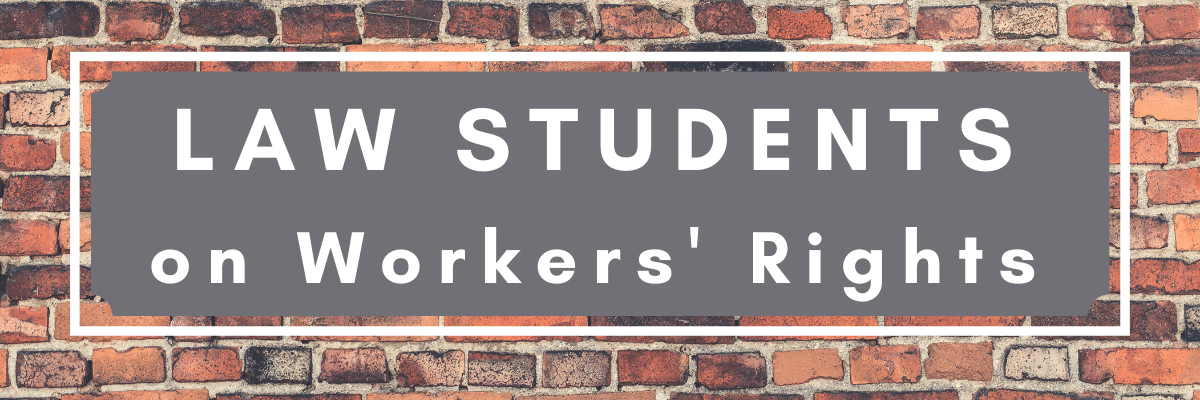
The Right to Freeload
July 22, 2020
The American Destruction of Unions
By Jonathan Harrington
Law Students on Workers’ Rights Series
The Law Students on Workers’ Rights series publishes essays from current and incoming students at some of the top law schools in the country. These essays, submitted for the Charles E. Joseph Employment Law Scholarship, address the question “What are the biggest challenges facing workers’ rights in the future?”
The history of America is the history of labor. From poor whites in the Antebellum South to striking railroad workers massacred in the 1800s to furloughed employees in the 2020 Coronavirus Pandemic, ordinary working people are the lifeblood of America.
Workers’ rights are human rights, and no one working their fingers to the bone at 40 hours per week should be living in poverty. Every such person should be able to afford adequate food, housing, and even some recreation.
In spite of this, over the last several decades, leaders in America from the Supreme Court down to the local legislatures have been engaged in an onslaught against workers and their most critical organizing tool: the union. The single biggest challenge workers are facing is the demonization and destruction of union organizing, which have been such a powerful engine of change in the lives of the American worker.
In my opinion, the single greatest threat to unions and workers is the deceptively-named “Right to Work” state, and the trend that these laws embody. These state laws – which force unions to negotiate on behalf of everyone, including workers who are hostile to unions – ought to be called the “Right to Freeload” laws.
These policies create a perverse and paradoxical incentive structure. While it is in every worker’s long term best interest to have a strong, robust labor movement with unions as a backbone, organizing costs money. In a “Right to Work” state, non-members get the same collective bargaining benefits as union members do, incentivizing them to catch a “free ride” at the bargaining table by not paying dues. The result is an erosion of the capacity of unions to negotiate on behalf of their members as non-members bleed them dry.
“Right to Work” states do not exist in a vacuum, however. They are part of an overall trend dating back to the end of the Warren Court – the Supreme Court headed by progressive chief justice Earl Warren. Over this period of time, we have seen increasing hostility toward workers by big business interests, politicians, and even the supposedly-neutral Supreme Court.
The trend continues with the case of Janus v. AFSCME (2018), which extended the court’s hostility toward unions. This case overturned more than 40 years of precedent decided in the Warren era in the case of Abood v. Detroit Board of Education, which allowed the collection of “agency fees” (“fair share fees”) for the purpose of collective bargaining and contract negotiations.
Abood explicitly excluded political advocacy – a perfectly reasonable reading of the first amendment. However, in 2018 the court decided that this did not decimate unions enough, so the court held that public sector workers must be entitled to a free ride in negotiations, clearly inspired by the corporate-backed “Right to Work” movement in America.
Over the past 40 years, the standard of living in America has been going down. Adjusted for inflation, the working class in America has not had a single raise in that time. Considering inflation, the federal minimum wage – a disgustingly inadequate seven dollars and a quarter per hour – has actually been decreasing over its decade-long stagnation. Workers are being pushed to the brink of starvation and poverty, being forced into second and third jobs, freelance and contract work with no benefits.
Change is needed, but elected leaders and unelected judges have been demonstrating increasing coziness with the big business and corporate interests in America at the expense of ordinary working people.
What is really needed is a resurgence of the labor movement in America to fight for the ordinary people who make this country great. We must reject the threats and hostile messaging the elite class in America has been handing down for a generation and embrace solidarity as we seek to lift the lowliest amongst us to a comfortable standing of living.
The only way to do this is through unionization of workers. Alone, we are weak, but together, we are strong. In the workplace, an injury to one is a concern for all, and victory for one is a victory for all.
Reflections from Charles Joseph
The history of labor in the U.S. has been one of struggle, from the fight for safe working conditions to the ongoing battles against wage theft, which costs workers $50 billion a year. While important legal fights have protected workers from discrimination and hostile work environments, a decades-long erosion of the power of unions has left many workers isolated and mistreated. As Jonathan reminds us, workers succeed best when they work together.
A native of South Florida, Jonathan Harrington studied English literature at the University of Miami. After graduating, he moved to Ft. Lauderdale and began a four-year career teaching public school. In 2020, he will attend the University of Florida for law school to continue his service to the public. Contact Harrington on LinkedIn.
Charles Joseph has over two decades of experience as an NYC employment lawyer. He is the founder of Working Now and Then and the founding partner of Joseph and Kirschenbaum, a firm that has recovered over $140 million for clients.